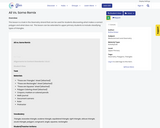
Geometry in Real-world Situations Mathematics Instructional Plan
- Subject:
- Mathematics
- Material Type:
- Lesson Plan
- Provider:
- VDOE
- Author:
- VDOE
- Date Added:
- 10/07/2024

Geometry in Real-world Situations Mathematics Instructional Plan

Characteristics of Solids Mathematics Instructional Plan

Classifying Quadrilaterals Mathematics Instructional Plan

Congruent Triangles Mathematics Instructional Plan

Side to Side Mathematics Instructional Plan

Compare and contrast the properties of quadrilaterals - Mathematics Instructional Plan

Deepen understanding of quadrilaterals - Rich Mathematical Task Template and Student Version

Translating and reflecting right triangles and rectangles on the coordinate plane - Mathematics Instructional Plan

3-D Figures Mathematics Instructional Plan

This lesson is a task in the Geometry strand that can be used for students discovering what makes a correct polygon and what does not. This lesson can be extended to upper primary students to include classifying types of triangles.https://goopenva.org/courses/1-g-all-vs-only-some

Learn why artists have been featuring food as a subject in their work for centuries. You’ve been told to eat your vegetables, but have you ever tried to paint them? Special Guest Lisa McLaughlin, the baker behind Jesse’s Girl Cookies, invites us into her kitchen to experiment with modern art techniques on cakes, and then we’ll make our own painting of a scrumptious treat inspired by 20th-Century painter Wayne Thiebaud.

"I prefer to think that we arrive at insight by experience..."-Josef Albers Examining art with a mathematical lens can help students articulate how they see and understand spatial and numerical relationships. Use this resoure to explore prints by artist and teacher Josef Albers to help students expand their understanding of geometric concepts such as parallel lines, congruent angles, rectangular prisms and more.The resource includes: Short introduction to Albers and his ideas.Examples of Albers works for examination. Suggested open-ended activity for further exploration Discussion prompts This activity can be structured as introductory exploration or informal formative evaluation. Use student ideas generated as a reference and springboard for more formal instruction and problem-solving.

This simulation allows you to observe the behavior of an object reflecting around a circular table.

Geometric characteristics of solid figures Mathematics Instructional Plans (MIPs) help teachers align instruction with the 2016 Mathematics Standards of Learning (SOL) by providing examples of how the knowledge, skills and processes found in the SOL and curriculum framework can be presented to students in the classroom.

Combining Polygons -- Mathematics Instructional Plans (MIPs) help teachers align instruction with the 2016 Mathematics Standards of Learning (SOL) by providing examples of how the knowledge, skills and processes found in the SOL and curriculum framework can be presented to students in the classroom.

This resource will show how to teach your students to make their own "formula calculator" using Java programming, and it has handouts for your students or your own use. It is ideal for Grade 7 and Grade 8 Math.The video in this resource walks you through the steps to teach your students to program their "formula calculator" using Java programming after they have been taught about geometric formulas. They can then use their calculator to help them solve their math problems. It will reinforce critical thinking skills and create a deeper understanding of how the formulas work.Students can use any Java IDE or even an online IDE. The lesson can be customized based on your familiarity with Java and your students' computer skills.The handouts show how to use arithmetic operators in Java as well as some Math class methods that will be helpful. The attached program can be used as a starting point for their programs.

Identifying and describing congruent and noncongruent figures -- Mathematics Instructional Plans (MIPs) help teachers align instruction with the Mathematics Standards of Learning (SOL) by providing examples of how the knowledge, skills and processes found in the SOL and curriculum framework can be presented to students in the classroom.

Angles in Polygons Mathematics Instructional Plan

Sea Cities Task Template and Student Version of Task

Angles, Arcs, and Segments Mathematics Instructional Plan